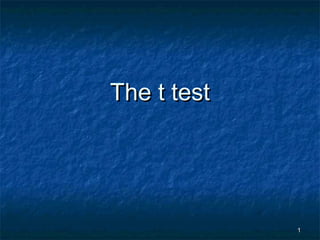
Stat5 the t test
- 1. The t test 1
- 2. Applications To compare the mean of a sample with population mean. To compare the mean of one sample with the mean of another independent sample. To compare between the values (readings) of one sample but in 2 occasions. 2
- 3. 1.Sample mean and population mean The general steps of testing hypothesis must be followed. Ho: Sample mean=Population mean. Degrees of freedom = n - 1 − X −µ t = SE 3
- 4. Example The following data represents hemoglobin values in gm/dl for 10 patients: 10.5 9 6.5 8 11 7 7.5 8.5 9.5 12 Is the mean value for patients significantly differ from the mean value of general population (12 gm/dl) . Evaluate the role of chance. 4
- 5. Solution Mention all steps of testing hypothesis. 8.95 − 12 t= = −5.352 1.80201 10 Then compare with tabulated value, for 9 df, and 5% level of significance. It is = 2.262 The calculated value>tabulated value. Reject Ho and conclude that there is a statistically significant difference between the mean of sample and population mean, and this difference is unlikely due to chance. 5
- 6. 6
- 7. 2.Two independent samples The following data represents weight in Kg for 10 males and 12 females. Males: 80 75 95 55 60 70 75 72 80 65 Females: 60 70 50 85 45 60 80 65 70 62 77 82 7
- 8. 2.Two independent samples, cont. Is there a statistically significant difference between the mean weight of males and females. Let alpha = 0.01 To solve it follow the steps and use this equation. − − X1 − X 2 t= 2 2 (n1 − 1) S1 + (n 2 − 1) S 2 1 1 ( + ) n1 + n 2 − 2 n1 n 2 8
- 9. Results Mean1=72.7 Mean2=67.17 Variance1=128.46 Variance2=157.787 Df = n1+n2-2=20 t = 1.074 The tabulated t, 2 sides, for alpha 0.01 is 2.845 Then accept Ho and conclude that there is no significant difference between the 2 means. This difference may be due to chance. P>0.01 9
- 10. 3.One sample in two occasions Mention steps of testing hypothesis. The df here = n – 1. − d t = sd n (∑ d ) 2 ∑ d2 − n sd = n −1 10
- 11. Example: Blood pressure of 8 patients, before & after treatment BP before BP after d d2 180 140 40 1600 200 145 55 3025 230 150 80 6400 240 155 85 7225 170 120 50 2500 190 130 60 3600 200 140 60 3600 165 130 35 1225 Mean d=465/8=58.125 ∑d=465 ∑d2=2917511
- 12. Results and conclusion t=9.387 Tabulated t (df7), with level of significance 0.05, two tails, = 2.36 We reject Ho and conclude that there is significant difference between BP readings before and after treatment. P<0.05. 12
